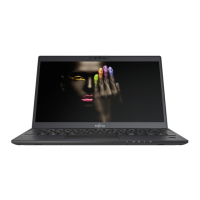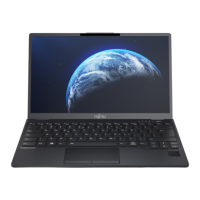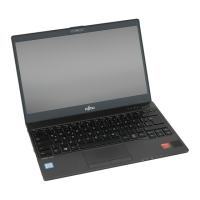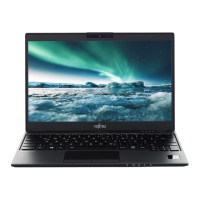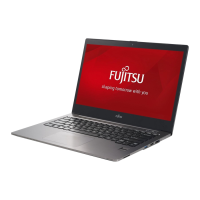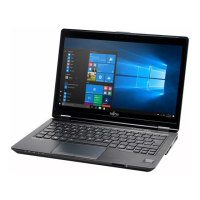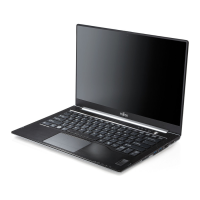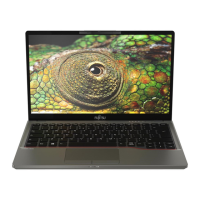Do you have a question about the Fujitsu LIFEBOOK U9311 and is the answer not in the manual?
Details on obtaining drivers, software, and advice for system usage.
Explanation of symbols, fonts, and formatting used throughout the manual.
Essential safety information and precautions for using the notebook.
Specific safety guidelines for wireless features like Wi-Fi and Bluetooth.
Tips and methods to conserve battery power and reduce energy consumption.
Advice and precautions for transporting and using the notebook while traveling.
Instructions and precautions for cleaning the notebook's exterior and screen.
Steps for unboxing the notebook and inspecting for any transit damage.
Guidance on choosing a suitable and safe environment for device operation.
Procedure for connecting the power adapter to the notebook and a power outlet.
Instructions for the initial power-on and software setup process.
Explanation of the various LED indicators on the notebook for status monitoring.
Steps to power on the notebook using the ON/OFF button.
Procedures for properly shutting down the notebook.
Overview of keyboard functions, special keys, and layout.
Information on using the integrated numeric keypad functions.
Details on using F-keys and Fn key combinations for various functions.
How to toggle between function keys and hotkeys.
Instructions for controlling the keyboard backlight.
Guidance on configuring keyboard layout and regional settings.
Usage instructions for the touchpad and its associated buttons.
How to control the cursor using the touchpad.
Steps to select items using the touchpad.
How to execute commands using the touchpad.
Method for moving items on screen using the touchpad.
Information on LCD screen characteristics and resolution.
Adjusting the brightness of the LCD screen.
Managing display output between the notebook and external displays.
How to interact with the touchscreen using finger gestures.
Information on using the built-in webcam and infrared camera.
Details on battery usage, charging, and maintenance.
How to utilize power-saving functions to extend battery life.
Optimizing system performance for power or speed.
Configuring fan speed for cooling and noise management.
Information on supported memory card formats and usage.
Details on audio output and input devices.
Instructions for inserting and managing a SIM card for mobile connectivity.
Information on enabling and using wireless network features.
How to connect to a wired network using the Ethernet port.
Introduction to the port replicator for expanded connectivity.
Overview of the various ports available on the port replicator.
Understanding the power and charging status indicators on the replicator.
Guidance on placing and connecting the port replicator.
Steps to connect the power supply to the port replicator.
How to physically connect the notebook to the port replicator.
Procedure for powering on the notebook using the port replicator.
Setting up and using the fingerprint sensor for authentication.
Information on the palm vein sensor for biometric authentication.
How to use a physical security lock to protect the notebook.
Setting up passwords for BIOS access and system boot.
Detailed steps for setting supervisor and user passwords in BIOS.
Procedures for creating and managing BIOS supervisor and user passwords.
Enabling password prompts before the OS starts.
Securing the hard disk with a password.
Activating and deactivating the TPM for enhanced security.
Information about using a SmartCard reader for authentication.
Steps for inserting a SmartCard into the reader.
Connecting external audio-visual devices via the HDMI port.
How to connect an external monitor using DisplayPort on the replicator.
Connecting various peripherals via USB ports.
Details on using the USB-C port for data, display, and charging.
How to use USB ports for charging external devices.
Safe procedures for disconnecting USB devices.
Connecting audio devices like headphones or microphones.
Instructions on how to access the BIOS Setup Utility.
Guide to navigating and changing settings within the BIOS.
Options for saving or discarding changes and exiting BIOS.
How to restore default BIOS settings.
How to discard unsaved changes without exiting BIOS.
How to save changes and continue configuring BIOS.
How to save changes and shut down the notebook.
Procedure for securely deleting data from hard drives or SSDs.
How to reset the notebook if it becomes unresponsive.
Steps for reinstalling the operating system using recovery media.
How to reset the system to its original state within Windows.
Troubleshooting steps for incorrect date and time settings.
Resolving issues where the keyboard inputs only numbers.
Troubleshooting steps for a blank notebook display.
Solutions for poor visibility or glare on the LCD screen.
Troubleshooting steps for an external monitor that shows no display.
Resolving issues with external monitor display stability.
Steps to troubleshoot when the notebook fails to power on.
Solutions for when the notebook unexpectedly shuts down or freezes.
Troubleshooting steps for printer connectivity and driver issues.
Diagnosing and fixing wireless network connection problems.
Troubleshooting steps when the SmartCard reader fails to detect a card.
Procedures for recovering a forgotten SmartCard PIN.
What to do if a SmartCard is lost or missing.
Explanations and resolutions for common BIOS and system error messages.
Specifications for ambient conditions, dimensions, and memory.
Technical details for the notebook's rechargeable battery.
Electrical specifications for the notebook's power adapter.
Electrical specifications for the port replicator's power adapter.
Information on proper disposal and recycling of the device and battery.
Information regarding TCO certification standards for the system.
Details on the specific absorption rate limits for the device.
Information on regulatory and certification marks applied to the device.
Details on obtaining drivers, software, and advice for system usage.
Explanation of symbols, fonts, and formatting used throughout the manual.
Essential safety information and precautions for using the notebook.
Specific safety guidelines for wireless features like Wi-Fi and Bluetooth.
Tips and methods to conserve battery power and reduce energy consumption.
Advice and precautions for transporting and using the notebook while traveling.
Instructions and precautions for cleaning the notebook's exterior and screen.
Steps for unboxing the notebook and inspecting for any transit damage.
Guidance on choosing a suitable and safe environment for device operation.
Procedure for connecting the power adapter to the notebook and a power outlet.
Instructions for the initial power-on and software setup process.
Explanation of the various LED indicators on the notebook for status monitoring.
Steps to power on the notebook using the ON/OFF button.
Procedures for properly shutting down the notebook.
Overview of keyboard functions, special keys, and layout.
Information on using the integrated numeric keypad functions.
Details on using F-keys and Fn key combinations for various functions.
How to toggle between function keys and hotkeys.
Instructions for controlling the keyboard backlight.
Guidance on configuring keyboard layout and regional settings.
Usage instructions for the touchpad and its associated buttons.
How to control the cursor using the touchpad.
Steps to select items using the touchpad.
How to execute commands using the touchpad.
Method for moving items on screen using the touchpad.
Information on LCD screen characteristics and resolution.
Adjusting the brightness of the LCD screen.
Managing display output between the notebook and external displays.
How to interact with the touchscreen using finger gestures.
Information on using the built-in webcam and infrared camera.
Details on battery usage, charging, and maintenance.
How to utilize power-saving functions to extend battery life.
Optimizing system performance for power or speed.
Configuring fan speed for cooling and noise management.
Information on supported memory card formats and usage.
Details on audio output and input devices.
Instructions for inserting and managing a SIM card for mobile connectivity.
Information on enabling and using wireless network features.
How to connect to a wired network using the Ethernet port.
Introduction to the port replicator for expanded connectivity.
Overview of the various ports available on the port replicator.
Understanding the power and charging status indicators on the replicator.
Guidance on placing and connecting the port replicator.
Steps to connect the power supply to the port replicator.
How to physically connect the notebook to the port replicator.
Procedure for powering on the notebook using the port replicator.
Setting up and using the fingerprint sensor for authentication.
Information on the palm vein sensor for biometric authentication.
How to use a physical security lock to protect the notebook.
Setting up passwords for BIOS access and system boot.
Detailed steps for setting supervisor and user passwords in BIOS.
Procedures for creating and managing BIOS supervisor and user passwords.
Enabling password prompts before the OS starts.
Securing the hard disk with a password.
Activating and deactivating the TPM for enhanced security.
Information about using a SmartCard reader for authentication.
Steps for inserting a SmartCard into the reader.
Connecting external audio-visual devices via the HDMI port.
How to connect an external monitor using DisplayPort on the replicator.
Connecting various peripherals via USB ports.
Details on using the USB-C port for data, display, and charging.
How to use USB ports for charging external devices.
Safe procedures for disconnecting USB devices.
Connecting audio devices like headphones or microphones.
Instructions on how to access the BIOS Setup Utility.
Guide to navigating and changing settings within the BIOS.
Options for saving or discarding changes and exiting BIOS.
How to restore default BIOS settings.
How to discard unsaved changes without exiting BIOS.
How to save changes and continue configuring BIOS.
How to save changes and shut down the notebook.
Procedure for securely deleting data from hard drives or SSDs.
How to reset the notebook if it becomes unresponsive.
Steps for reinstalling the operating system using recovery media.
How to reset the system to its original state within Windows.
Troubleshooting steps for incorrect date and time settings.
Resolving issues where the keyboard inputs only numbers.
Troubleshooting steps for a blank notebook display.
Solutions for poor visibility or glare on the LCD screen.
Troubleshooting steps for an external monitor that shows no display.
Resolving issues with external monitor display stability.
Steps to troubleshoot when the notebook fails to power on.
Solutions for when the notebook unexpectedly shuts down or freezes.
Troubleshooting steps for printer connectivity and driver issues.
Diagnosing and fixing wireless network connection problems.
Troubleshooting steps when the SmartCard reader fails to detect a card.
Procedures for recovering a forgotten SmartCard PIN.
What to do if a SmartCard is lost or missing.
Explanations and resolutions for common BIOS and system error messages.
Specifications for ambient conditions, dimensions, and memory.
Technical details for the notebook's rechargeable battery.
Electrical specifications for the notebook's power adapter.
Electrical specifications for the port replicator's power adapter.
Information on proper disposal and recycling of the device and battery.
Information regarding TCO certification standards for the system.
Details on the specific absorption rate limits for the device.
Information on regulatory and certification marks applied to the device.
